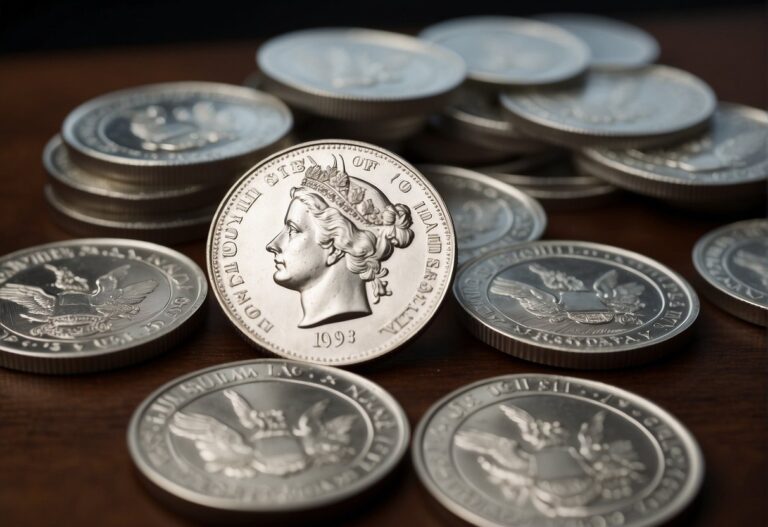In evaluating whether a Gold IRA is a good investment, it’s essential to recognize that it offers a unique form of retirement diversification. A Gold IRA allows investors to hold physical gold and other precious metals within a retirement account.
This can appeal to those seeking a hedge against inflation and currency devaluation, with gold historically maintaining its value over the long term.

Understanding the structure and requirements of a Gold IRA is crucial for investors. It’s a type of self-directed IRA that necessitates adhering to specific IRS regulations regarding the storage and handling of the metals. Investors must consider the fees associated with these accounts, including setup, storage, and insurance costs, and understand the tax implications that differentiate them from traditional and Roth IRAs.
Is A Gold IRA A Good Investment Key Takeaways
- Gold IRAs offer a hedge against market volatility and inflation.
- They require an understanding of specific IRS regulations and entail additional fees.
- Comparing Gold IRAs to traditional retirement accounts is essential to make an informed decision.
Understanding Gold IRAs

Gold IRAs offer a distinctive way to diversify one’s portfolio when exploring retirement investment options. They uniquely merge the self-directed nature of alternative investments with the stability of precious metals.
Definition and Functioning of A Gold IRA
A Gold IRA is a self-directed individual retirement account that allows holding physical gold and other precious metals as part of the retirement portfolio. Unlike a traditional IRA or Roth IRA, which typically holds stocks, bonds, and mutual funds, a Gold IRA focuses on gold as a long-term investment.
One typically needs a custodian to manage the IRA and a reliable depository to store the physical gold securely.
- Financial institutions: Act as custodians and handle transactions, paperwork, and compliance.
- Storage: Physical gold must be stored in an IRS-approved depository to meet legal requirements.
Types of Gold IRAs
There are two main types of Gold IRAs, each aligning with established retirement account frameworks:
- Traditional Gold IRA: Funded with pre-tax dollars, taxes on contributions and gains are deferred until withdrawal.
- Roth Gold IRA: Funded with after-tax dollars, allowing for tax-free growth and withdrawals, assuming certain conditions are met.
Both types of Gold IRAs offer the potential for financial growth and serve as a hedge against inflation and market volatility, capitalizing on the historical resilience of gold values.
The Role of Precious Metals in Investment Portfolios

Precious metals, particularly gold, have been a cornerstone in investment portfolios for their attributes as diversifiers and hedges against inflation. They offer unique advantages that can fortify an investment strategy.
Diversification Benefits
Investors often turn to precious metals to diversify their portfolios. The primary reason is that precious metals tend to have a low or negative correlation with other asset classes, such as stocks and bonds. This means that when stocks and bonds experience a downturn, precious metals might hold their value or even increase in price, helping to reduce overall portfolio risk.
Gold’s Historical Resilience
Gold has a long-standing reputation for its historical resilience. Over centuries, physical gold has not only been a symbol of wealth but has also served as a hedge against inflation and market volatility.
Gold’s enduring value is evident during economic uncertainty, often retaining its purchasing power even when fiat currencies weaken. Investors view gold as a safeguard to maintain the long-term value of their portfolio.
Tax Implications of Gold IRAs

When considering a Gold IRA, it is crucial to understand the specific tax implications that impact contributions, distributions, and the overall tax benefits of such an investment.
Gold IRA Contribution and Distribution Rules
Gold IRAs are subject to annual contribution limits that align with traditional IRA limits. For the tax year 2023, individuals can contribute up to $6,000 or $7,000 if they are 50 or older.
Distributions from a traditional Gold IRA are taxed as ordinary income, and early withdrawals before age 59½ may incur a 10% penalty in addition to the income tax due.
Regarding distributions, there are critical points to note:
- Mandatory distributions begin at age 72, as with traditional IRAs.
- Roth Gold IRAs do not require distributions during the owner’s lifetime, and qualified withdrawals are tax-free.
Understanding the Tax Benefits of Gold IRAs
Investing in a Gold IRA possesses certain tax advantages. Contributions to a traditional Gold IRA may be tax-deductible depending on one’s income and filing status.
While the metals inside the account grow tax-deferred, taxes are only due upon withdrawal.
The Roth Gold IRA offers different benefits:
- Contributions are made with after-tax dollars.
- Growth and withdrawals are tax-free if the account has been open for at least five years and the owner is 59½ years old.
Physical gold in these IRAs must adhere to IRS fineness standards and be held in an IRS-approved depository. One must be aware that the IRS considers gold as a collectible, and long-term gains from sales outside of an IRA can be taxed up to 28%.
However, within a Gold IRA, these gains are sheltered from immediate taxation, illustrating the potential of a Gold IRA as a tax-efficient investment vehicle.
Comparing Gold IRAs with Other Retirement Accounts

Investors often weigh the pros and cons of various retirement accounts, including Gold IRAs, Traditional and Roth IRAs, and stocks and bonds, to diversify their portfolios and minimize risk.
Gold IRA vs Traditional IRA and Roth IRA
A Gold IRA permits the inclusion of gold and other precious metals in a retirement portfolio, providing a hedge against market volatility and inflation. Unlike Traditional and Roth IRAs, which deal primarily with paper assets like stocks, mutual funds, and bonds, Gold IRAs allow for physical investments in precious metals.
- Traditional IRAs may offer tax-deductible contributions, with taxes deferred until withdrawal.
- Roth IRAs feature after-tax contributions, with the benefit of tax-free withdrawals on qualified distributions.
- Gold IRAs have tax advantages similar to traditional IRAs. However, they require a custodian for the physical assets and may involve higher fees.
Investors often compare the potential long-term appreciation of precious metals against the return of paper assets in traditional retirement accounts.
While gold may not yield dividends like stocks or interest like bonds, it can potentially be a diversification tool to mitigate risk.

Get Matched With A Vetted
GOLD IRA ADVISOR TODAY
Gold IRA vs. Stocks and Bonds
When comparing Gold IRAs to investments in stocks and bonds, one must consider market exposure and performance under different economic conditions.
- Stocks offer the potential for high returns due to equity stakes in companies but come with higher risk and volatility.
- Bonds provide a fixed income over time and are generally considered safer than stocks but may yield lower returns.
Gold IRAs, on the other hand, are not directly tied to stock market performance. Gold’s price tends to move inversely to the stock market, which can provide balance in a portfolio during times of economic downturn.
- Stocks and Bonds are subject to the performance of the financial markets and the economic conditions.
- Gold and Precious Metals in a Gold IRA can act as a safeguard during periods of economic uncertainty, albeit with the potential of lower returns than equities in the long run.
When choosing between a Gold IRA and more traditional investments like stocks and bonds, investors must carefully consider the costs, tax implications, and investment goals.
Investment Options within Gold IRAs

Gold IRAs offer a specialized investment avenue for those interested in diversifying their retirement portfolio with precious metals. Within these accounts, investors can choose from physical assets, such as coins and bullion, or financial instruments, like ETFs and mining stocks.
Gold IRA Coins and Bullion
Investors can include various types of physical gold in coins and bullion bars. Coins must meet the IRS fineness standards of 0.995 or greater and should be produced by a government mint.
Notable examples of coins eligible for Gold IRAs include the American Eagle, Canadian Maple Leaf, and Austrian Philharmonic coins.
Conversely, bullion refers to gold bars of different weights, often ranging from one ounce to several kilograms. When considering bullion, investors should be aware that an IRS-approved custodian must hold the gold, which comes with storage fees.
ETFs and Mining Stocks
Investors may also opt for gold-related financial assets like exchange traded Funds (ETFs) and mining stocks. ETFs are investment funds traded on stock exchanges, much like stocks. Gold ETFs typically track the price of gold and offer a more liquid means to invest in gold without owning physical gold.
Mining stocks represent shares in companies that are involved in the extraction and production of gold. By purchasing these stocks, investors gain exposure to gold prices as the profitability of mining companies often correlates with the market value of gold.
However, mining stocks carry risks not directly tied to gold prices, including operational and management risks.
Setting Up a Gold IRA Account

When considering a Gold IRA for retirement savings, one must take specific steps to ensure the account is set up correctly and compliantly. This involves selecting the proper custodian and understanding the intricacies of purchasing and storing the physical metals.
Choosing a Gold IRA Custodian
A custodian is an IRS-approved financial institution responsible for the security and management of a Gold IRA. Investors must choose a custodian wisely, as this entity will handle purchasing, exchanging, and storing the precious metals.
When selecting a custodian, consider their experience, fee structure, and the variety of gold products they offer. Top gold IRA companies typically partner with reputable custodians and can provide a list of preferred options.
Purchase and Storage of Precious Metals
Once a custodian is chosen, purchasing gold or other precious metals can proceed. These purchases must adhere to the IRS standards for purity and weight. After acquisition, the metals must be stored in an IRS-approved depository.
The chosen depository must provide secure, insured storage options to protect the investment. Some custodians may offer storage solutions with various levels of insurance to safeguard against potential losses.
Fees and Expenses of Gold IRAs

Before committing to this investment, investors should comprehend the unique fee structure and expenses related to Gold IRAs.
Understanding Gold IRA Costs
Gold IRAs incur several types of fees that traditional retirement accounts do not. An individual must account for setup, annual maintenance, and storage fees.
For instance, segregated storage may attract higher fees, between $100 to $300 annually, while non-segregated (commingled) storage options can cost between $50 to $150 annually.
Most providers also impose a seller’s fee, or “spread,” and there might be additional costs for insurance to protect the physical gold. It’s important to note that these expenses can vary based on the amount of gold in the IRA and the specific policies of the custodian and storage facility.
Comparing Different Gold IRA Companies
When considering a Gold IRA, one should carefully evaluate different providers. It’s imperative to scrutinize the detailed fee structures as they can significantly impact the profitability of gold investments. Investors should compare the annual maintenance and storage fees, as they can differ from one custodian to another.
Providers may also differ in the insurance coverage they offer for the stored gold, with varying levels of protection and associated costs. Understanding what one’s getting for potentially higher fees is essential, as these costs can erode investment returns over time.
It’s advisable to review all the costs associated with each provider, including any fees for purchasing or selling the gold within the IRA.
Risks and Considerations for Gold IRA Investors

Investing in a Gold IRA can provide a hedge against inflation and economic uncertainty. However, investors must understand the associated risks and considerations before committing funds.
Gold IRA Market Volatility and Pricing
The price of gold is highly volatile, subject to rapid fluctuations based on numerous market factors. This volatility can affect the value of a Gold IRA, as gold prices do not always move in tandem with traditional securities like stocks and bonds.
Investors need a clear understanding of the gold market dynamics and a substantial risk tolerance to navigate the volatile nature of gold investments.
Potential for Losses and Penalties
While a Gold IRA can be a protective asset, it’s not immune to losses. Gold does not generate income such as interest or dividends, which means its profitability relies solely on capital gains. Moreover, investors should know the penalties for early withdrawal from an IRA and the potential tax implications. I think carefully considering these factors is essential to avoid any financial impact.
Regulations and Protections Governing Gold IRAs

Gold IRAs are governed by specific IRS regulations that mandate the types of metals allowed, contribution limits, and the use of approved depositories. These rules are designed to protect investors and maintain the tax advantages of the retirement account.
Gold ira IRS Regulations and Limits
In a Gold IRA, the Internal Revenue Service (IRS) has delineated clear guidelines regarding the types of precious metals allowed. Approved precious metals must meet specific purity standards; for example, gold must be 99.5% pure. In addition to purity requirements, strict contribution limits must be adhered to.
For 2023, the contribution cap is generally $6,500, with an additional $1,000 allowed for individuals over 50, aligning with traditional IRA limits.
Furthermore, the IRS mandates that assets in a Gold IRA must be held in an IRS-approved depository. Investors can only take physical possession of the gold without facing taxes and penalties; the metals must be stored at a facility that meets security and insurance standards.
Investor Rights and Recourse
Investors are entitled to certain rights when dealing with their Gold IRA. They can select their IRS-approved depository, ensuring their assets are securely stored. Suppose an investor’s rights are not respected, or there is a breach of the obligations by the custodian or depository. In that case, they have the recourse through legal channels to address the concerns.
The IRS also categorically prohibits Gold IRAs from holding any investment termed as a “collectible,” which includes certain coins and metals that do not meet the purity specifications.
This ensures a uniform standard of investment within these retirement accounts.
Investors must be vigilant in choosing the proper custodian and depository to ensure compliance with their precious metals IRA regulations.
Strategies for Optimizing Your Gold IRA

When considering a Gold IRA as part of one’s retirement planning, adopting a robust investment strategy and financial plan is essential to ensure the gold holdings contribute effectively to one’s retirement portfolio. This includes knowing the opportune moments to buy and sell and how to maintain a balanced and diversified portfolio.
When to Buy and Sell Gold
One of the critical factors in optimizing a Gold IRA involves identifying the correct times to enter or exit the market. The price of gold can be volatile, and knowing when to buy often relates to periods of economic uncertainty when gold prices typically rise as investors look for safe-haven assets.
Conversely, they can consider selling when the market peaks or when portfolio rebalancing requires reducing gold exposure.
Due diligence and market trend analysis are vital components of the decision-making process to maintain liquidity and a growth-oriented financial plan.
Balancing Your Retirement Portfolio
In a diversified retirement portfolio, gold should be balanced with other assets such as stocks, bonds, and mutual funds. Gold is a hedge against inflation but should not overshadow other growth-oriented investments.
A common rule of thumb is to allocate a small percentage of the portfolio to precious metals, although this will vary according to individual risk tolerance and retirement goals.
Regular reviews and adjustments will help individuals adhere to their retirement planning objectives, maintaining the right mix of liquidity, security, and potential for long-term growth.
The Future of Gold IRAs and Precious Metals

Investors considering a gold IRA will find that future trends and economic factors are pivotal in the viability of precious metals as a retirement savings option. Understanding these elements is crucial to foresee the potential of gold IRAs as a hedge against market volatility.
Gold Trends and Predictions
The demand for gold and other precious metals within individual retirement accounts is expected to be sustained, mainly due to their historical performance during inflation and financial uncertainty.
Analysts anticipate that, as trust in traditional investments fluctuates with market volatility, interest in gold IRAs may experience an upward trend.
Technological advancements and streamlined processes are making gold IRAs more accessible, suggesting a positive outlook for growth in this sector.
Economic Factors Impacting Gold
Economic indicators play a significant role in shaping the landscape for gold investments. Inflation, often called the “silent thief” of purchasing power, typically strengthens the appeal of gold. During a financial crisis, gold has historically been a go-to asset for its store of value.
As central banks and governments continue to grapple with economic downturns, the strategic inclusion of gold in a retirement portfolio can be an effective diversification strategy that helps mitigate risks associated with market volatility.
Gold IRA Frequently Asked Questions

Investors often have specific queries about the intricacies of Gold IRAs and how they align with retirement goals. This section addresses some of the most common questions.
What are the advantages of investing in a Gold IRA over other types of IRAs?
A Gold IRA offers diversity in retirement portfolios, potentially reducing the risk associated with market volatility. Metals can protect against inflation, providing a potential safeguard for purchasing power.
In what ways does a Gold IRA differ from buying physical gold directly?
Investing in a Gold IRA involves special IRS regulations. It requires a custodian to manage the account, whereas buying physical gold directly gives the investor ownership without needing a custodian or adherence to IRA-specific rules.
Can a Roth IRA be composed entirely of gold investments, and what are its benefits?
Yes, a Roth IRA can be composed entirely of gold investments. Its benefits include tax-free growth and withdrawals, offering a tax-efficient way to invest in gold.
How does investing in a Gold IRA compare to a traditional 401k plan?
A Gold IRA offers investment in physical assets, which can diversify retirement savings. In contrast, a traditional 401k typically invests in stocks, bonds, and mutual funds, with different tax treatments and withdrawal rules.
What are some top factors to consider when choosing a Gold IRA company?
Investors should consider the company’s reputation, fees, customer service, storage safety, and whether they offer buyback programs. Due diligence is essential in selecting a Gold IRA company that aligns with investment goals.
What minimum initial investment is required to open a Gold IRA account?
The typical initial investment for a Gold IRA can range from $5,000 to $25,000, depending on the provider’s policies and the types of metals purchased.




